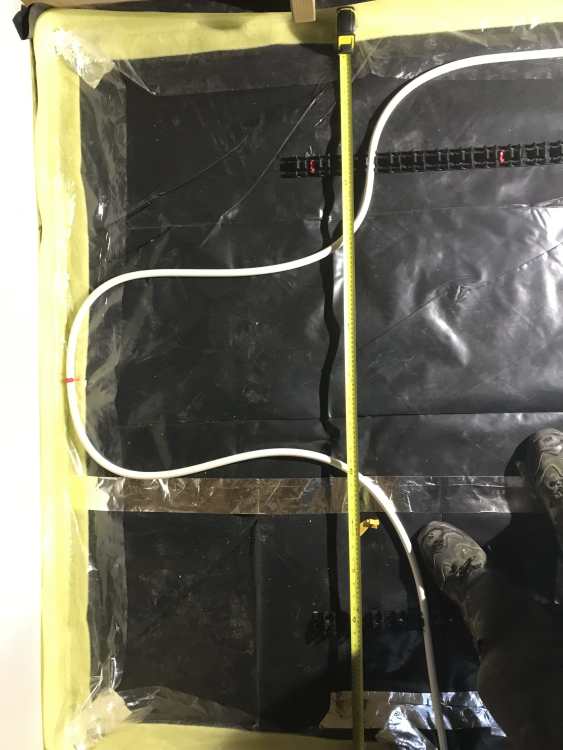
Nestor
Members-
Posts
711 -
Joined
-
Last visited
-
Days Won
6
Nestor's Achievements

Regular Member (4/5)
301
Reputation
-
Thanks Nick, this was just an internal cupboard but do understand the principle. Thought that these perimeter strips were more to allow for expansion and stopping the screed escaping, the external walls are 420mm wide! Have a great Christmas.
-
I have enclosed a shot, it is inside a hall cupboard! I fitted 150mm celotex tight to the walls, taped all the joints, fitted plastic sheet, taped then UFH. The perimeter edge insulation has an adhesive strip on one side which fixes to the upstand / wall and polythene apron which lies on the floor. Just need to make sure the screed cannot escape. Hope that helps.
-
Oak worktop and Osmo Top Oil (3068 Natural version)
Nestor replied to paro's topic in Kitchen Units & Worktops
I installed similar worktops in 2006, very pleased with them. The final surface was a smooth as glass. Once in use the minor blemishes will hopefully become less relevant. Easy to maintain, every couple of years I would rub down with wire wool / sandpaper and reapply with a cloth. I did test the 3068 but found the white pigment interfered with the actual colour of the wood, this was a few years back. -
Clicked on the link expecting details about U values and weather compensation curves. Lovely surprise. Best landlord .
-
Oak worktop and Osmo Top Oil (3068 Natural version)
Nestor replied to paro's topic in Kitchen Units & Worktops
Not quite the same but have just painted 14 flush plywood internal doors with black Osmo Oil stain. I did 3 coats, first 2 applied with a 4" roller and sanded with 320. Top coat applied very liberally with lint free cloth wrapped around a hand pad holder, Osmo do a fleece, link below. https://www.wood-finishes-direct.com/product/osmo-hand-applicator-fleece?sid=1&s=3970027-c23026905f54b60afc435908c3958a1f&r=10&p=1 Have you noticed any white pigment in the 3068? -
As @Conor Can you confirm the quality of the tile, even thickness at either end and centre. Perfectly flat or any bowing? Can you run a straight edge across the vertical surface for a photo.
-
I used the In screed cable from here, have a read around. https://flexel.co.uk/product-category/underfloor-heating/ Just check the UFH matting adheres to the board, the self levelling will help bond it all together. Regarding threshold heights, on a new self build it can become a bit obsessive. Just do your best with the materials available. Do another section drawing in mm with the new materials for your own peace of mind including tile and the adhesive. Make a start, hopefully using large format tiles! I had over 1100 hexagonal and small rectangonal tiles to fit in our Wetroom. Never again. I used https://www.protilertools.co.uk as well.
-
I. agree, you agree. It was really a comment on @ETC contributions. Addressing overbearing and cramped should get this passed.
-
Progress, Option 1. Huge improvement. Great to see a contemporary new build design instead of rehashing the existing vernacular. Personally, it is a tricky site with minimal parking for both properties, I think a 3 bed with attached garage would be acceptable.
-
From our window experience it was all such a disappointment, especially the fitting which they do everyday! I think an independent report would be advisable to move forward. Lovely looking home, btw.
-
Some random thoughts, not a professional but built a house with 4 bathrooms. A level threshold to the bedroom would be very critical for me, within a few mm. I fitted wet UFH in foiled EPS boards under the 6mm Hardie Backer and electric cable in a 50mm sand & cement screed. You could use 18mm P5 or 12mm Hardie Backer above the insulation and slab but would need to be fixed well, no movement. I think fixed battens to the slab would work. Electric, (is it self adhesive matting) fitted to one of the above then apply thin layer of self levelling to encapsulate heating elements. Then tank and tile. What the Boss @Nickfromwales said.
-
What Nick said, A tiled floating floor wet room does not work for me, I would want it all fixed with zero movement. When I tiled our wet room I fixed Hardie backer board through to the P5 Caberdek which is fixed to the floor joists.
-
Floating so battens not fixed to the slab?
-
Clippa plate or similar between joist ufh
Nestor replied to Selfbuildsarah's topic in Underfloor Heating
As above. -
It is all subjective but I would not call this " a prominent corner plot" even though the case officer seems to be on your side. It is overbearing and cramped. All are semis with a driveway between except number 42 with a separate garage at the rear. You have had 19 letters of objection. Upset the Arboricultural Officer and Natural England. No property in the street has had a two storey extension built. All single storey wraparound. Look at no 33 for ideas, looks like garage with a mono pitch roof or imagine no 42 with an attached garage.



